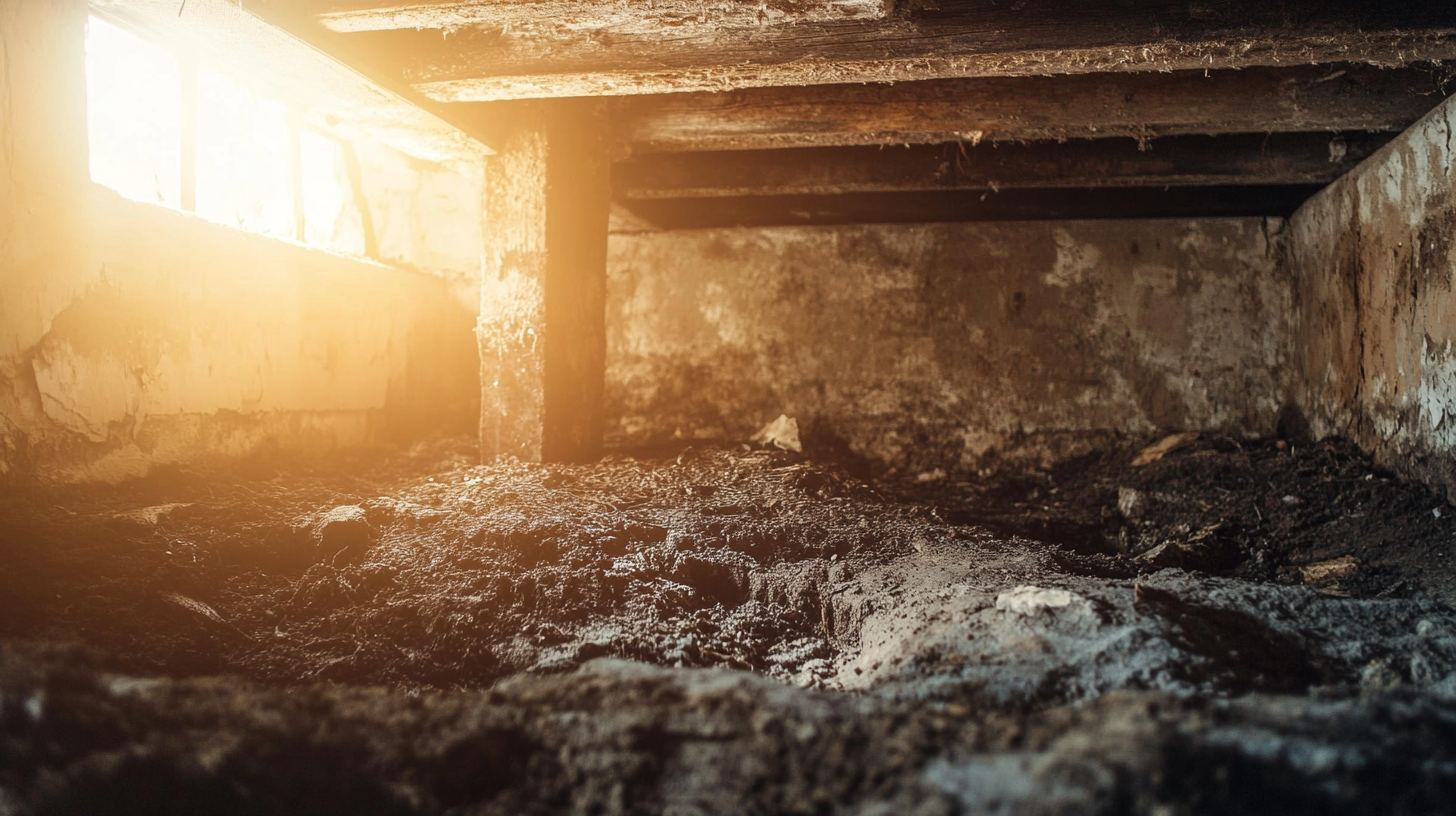Now IS THe Time To...

Crawl Space Services In Knoxville, TN
Stetson Howard: 865-432-6743
CRAWL SPACE ENCAPSULATION, REPAIR, WATERPROOFING & MOLD REMOVAL
No-Obligation, Free Inspections
No-Obligation Free Estimates
We Warranty All of Our Work
100% Satisfaction Guaranteed
In the quest to protect our homes from the myriad challenges posed by nature, the sump pump stands as a silent sentinel against one of the most pervasive threats: water damage. Nestled in the lowest part of the basement or crawl space, this unassuming device plays a pivotal role in safeguarding the structural integrity of our homes and the health of our living environments. As homeowners, understanding the function, importance, and operation of sump pumps is essential in our arsenal of home maintenance strategies. This blog serves as an introduction to sump pumps, highlighting their critical component in preventing basement flooding and ensuring peace of mind during even the most torrential downpours.
Water has a relentless nature, seeking entry into our basements through cracks, seams, and the very foundation that supports our homes. Without proper management, this intrusion can lead to flooding, property damage, and the proliferation of mold and mildew, compromising both the safety of our structures and the quality of our indoor air. Herein lies the significance of the sump pump: a proactive mechanism designed to intercept and expel water away from our homes, maintaining dry and healthy basements and crawl spaces.
The journey of a sump pump begins with its strategic placement in a sump pit, where water collects either through direct flow or via drainage systems. Upon reaching a certain level, the pump is activated—thanks to an integral float switch—propelling water out through a discharge line and away from the home's foundation. This cycle of collection and expulsion is a homeowner's first line of defense against the insidious creep of water damage.
As we delve deeper into the world of sump pumps, we'll explore the various types available, key considerations for installation, maintenance tips to ensure optimal performance, and troubleshooting advice for common issues. Whether you're a seasoned homeowner looking to refine your water management strategy or a new homeowner seeking to understand the essentials of basement waterproofing, this blog aims to equip you with the knowledge and insights necessary to leverage the full potential of sump pumps in protecting your home.
Join us as we embark on this informative journey, shedding light on the indispensable role of sump pumps in maintaining the sanctity and safety of our homes against the ever-present challenge of water intrusion.
Understanding Flood Risks in Homes
Flooding poses a significant risk to homes, particularly in the basement area, where water tends to accumulate due to various environmental factors. Understanding the common causes of basement flooding and the potential consequences can help homeowners take proactive measures to protect their property. This section provides an overview of the primary sources of basement flooding, including heavy rainfall, snowmelt, and high water tables, and discusses the damage and long-term issues that can arise from such events.
Common Causes of Basement Flooding
Overview of How Heavy Rainfall, Snowmelt, and High Water Tables Contribute to Flooding
- Heavy Rainfall: Intense or prolonged rainstorms can overwhelm drainage systems and lead to water pooling around the foundation of a home. If the water pressure outside the basement walls becomes too great, water can seep through cracks and openings, resulting in flooding.
- Snowmelt: Rapid snowmelt during warm spells can saturate the ground around a home, similar to the effects of heavy rainfall. If the ground is frozen or the drainage system is inadequate, water can accumulate and infiltrate the basement.
- High Water Tables: Homes built in areas with high water tables are particularly susceptible to basement flooding. During periods of heavy rain or snowmelt, the water table can rise, increasing the risk of water seeping into the basement through the foundation.
Recognizing these common causes can help homeowners identify their risk level and implement appropriate flood prevention strategies.
Consequences of Basement Flooding
Discussion on the Potential Damage and Long-Term Issues Caused by Basement Floods
Basement flooding is not just a nuisance; it can lead to significant damage and long-term issues, including:
- Structural Damage: Prolonged exposure to water can weaken the foundation and structural elements of a home, leading to costly repairs.
- Mold and Mildew Growth: Moist environments are ideal for the growth of mold and mildew, which can cause health problems and damage to interior finishes and belongings.
- Electrical Hazards: Water intrusion in basements can pose serious risks if it comes into contact with electrical systems or appliances.
- Property Loss: Flooding can damage or destroy personal property stored in the basement, including furniture, electronics, and sentimental items.
Understanding the consequences of basement flooding underscores the importance of taking preventive measures to protect your home. Implementing solutions such as proper landscaping, maintaining gutters and downspouts, and installing a sump pump system can significantly reduce the risk of basement flooding and its associated damages.
Basics of Sump Pump Operation
A sump pump is an essential tool in the battle against basement flooding, acting as a first line of defense to keep your home dry and protected from water damage. Understanding how sump pumps work and the different types available can help homeowners make informed decisions about their flood prevention strategies. This section provides a detailed explanation of the mechanics behind sump pump operation and offers an overview of the two primary types of sump pumps: submersible and pedestal.
How Sump Pumps Work
Explanation of the Mechanics of a Sump Pump and How It Removes Water
A sump pump is designed to efficiently remove accumulated water from your basement or crawl space. The process begins with the collection of excess water in a sump pit, typically located at the lowest point of the basement. As water fills the pit, a float switch is activated once the water reaches a predetermined level, triggering the pump to start. The pump then expels the water through a discharge pipe, directing it away from your home's foundation to a designated drainage area. This cycle of activation and water removal continues as needed to keep the basement dry.
The effectiveness of a sump pump depends on several factors, including the correct installation of the pump and discharge line, regular maintenance, and the suitability of the pump type for the specific demands of the property.
Types of Sump Pumps
Overview of Submersible and Pedestal Sump Pumps and Their Respective Roles in Flood Prevention
Sump pumps come in two main varieties, each with its advantages and specific applications:
- Submersible Sump Pumps: These pumps are designed to be placed directly in the sump pit, submerged in water. Their compact design makes them less obtrusive and quieter during operation. Submersible pumps are typically more powerful and better suited for homes that experience higher volumes of water accumulation. The motor is sealed within a waterproof housing, protecting it from moisture and debris.
- Pedestal Sump Pumps: Pedestal pumps feature a motor mounted above the sump pit, with a long shaft extending down into the pit to the pump impeller. This design keeps the motor out of the water, potentially extending its lifespan. Pedestal pumps are easier to access for maintenance and may be a more cost-effective option for homes with lower flood risks. However, they are generally less powerful than submersible pumps and can be more noticeable due to their above-pit placement.
Choosing between a submersible and pedestal sump pump depends on your home's specific needs, including the typical water volume, the size of the sump pit, and budget considerations. Understanding the operational mechanics and the differences between these pump types can guide homeowners in selecting the most appropriate sump pump system for effective flood prevention.
The Role of Sump Pumps in Flood Prevention
In regions where basements are prone to flooding due to heavy rainfall, high water tables, or melting snow, sump pumps serve as a critical defense mechanism. These devices not only actively remove water from the lowest point of your basement but also play a pivotal role in preventing water damage and mold growth. Understanding the functionality of sump pumps and their contribution to maintaining a dry and healthy home environment is essential for any homeowner looking to mitigate flood risks. This section explores how sump pumps work to actively remove water and their importance in preventing structural damage and mold proliferation.
Active Water Removal
How Sump Pumps Actively Remove Water from the Lowest Point of Your Basement
Sump pumps are specifically designed to combat basement flooding by actively removing water that accumulates in the sump pit, typically located at the basement's lowest point. Here's how the process works:
- Water Collection: As water enters the basement, it naturally flows to the sump pit, thanks to the basement's gradient or via perimeter drains.
- Activation: Once the water in the sump pit reaches a certain level, the sump pump's float switch is triggered, activating the pump.
- Water Evacuation: The pump then propels the water through a discharge pipe, directing it away from the home's foundation to a safe drainage area.
This active water removal process is continuous, with the sump pump automatically activating as needed to keep the basement dry. By efficiently managing water accumulation, sump pumps prevent the potential for flooding, safeguarding your home's foundation and interior spaces.
Preventing Water Damage and Mold
Discussion on How Sump Pumps Prevent Structural Damage and Mold Growth by Keeping Basements Dry
The benefits of a sump pump extend beyond mere water evacuation; they are instrumental in preserving the structural integrity of your home and ensuring a healthy living environment:
- Structural Damage Prevention: By keeping the basement dry, sump pumps prevent water from weakening the home's foundation and structural components. Prolonged exposure to moisture can cause concrete to deteriorate and wood to rot, leading to significant structural issues.
- Mold and Mildew Mitigation: Mold and mildew thrive in moist environments. A dry basement, maintained by a functioning sump pump, significantly reduces the risk of mold and mildew growth. This not only protects the home's structural materials but also safeguards the health of its inhabitants by preventing the spread of mold spores.
In essence, sump pumps are a proactive measure against the challenges posed by basement water accumulation. Their role in actively removing water and maintaining a dry environment is invaluable in preventing water damage, structural deterioration, and the proliferation of mold and mildew.
Key Features of Sump Pumps for Effective Flood Prevention
To safeguard your home from the potential devastation of flooding, it's crucial not just to have a sump pump installed but to ensure it possesses features that align with your home's specific needs. The effectiveness of a sump pump in preventing flood damage hinges on several key features, notably its capacity and efficiency, as well as the inclusion of backup systems and alarms. This section delves into the importance of these features, guiding homeowners on what to look for when selecting a sump pump to ensure optimal flood prevention.
Pump Capacity and Efficiency
Importance of Selecting a Sump Pump with the Right Capacity for Your Home's Needs
The capacity of a sump pump, measured in gallons per hour (GPH) or gallons per minute (GPM), indicates the volume of water it can remove within a specific timeframe. Selecting a sump pump with the appropriate capacity is critical for several reasons:
- Adequate Water Removal: The pump must be capable of handling the typical volume of water accumulation in your basement, especially during peak conditions like heavy rainstorms or rapid snowmelt.
- Efficiency: A pump with too high a capacity for your needs may cycle on and off more frequently, leading to unnecessary wear and reducing its lifespan. Conversely, a pump with insufficient capacity may struggle to keep up with water inflow, risking basement flooding.
Consider factors such as the size of your basement, historical water accumulation rates, and the area's rainfall patterns when determining the necessary pump capacity. Consulting with a professional can also provide valuable insights into the best pump size for your specific situation.
Backup Systems and Alarms
The Role of Battery Backup Systems and Alarms in Ensuring Continuous Operation During Power Outages
Power outages during severe weather events can incapacitate electrically powered sump pumps precisely when they're needed most. Incorporating backup systems and alarms into your sump pump setup can mitigate this vulnerability:
- Battery Backup Systems: A battery-powered backup sump pump kicks in if the primary pump fails or if there's a power outage, providing an additional layer of protection against flooding. Some systems are designed to automatically switch to battery power, while others may operate as a separate, standalone pump.
- Alarms: Sump pump alarms alert homeowners to high water levels in the sump pit, indicating potential issues with the pump's operation. Advanced systems may even offer remote monitoring capabilities, allowing you to receive alerts on your phone or computer.
These features are essential for ensuring that your sump pump system remains operational in all conditions, offering peace of mind and significantly reducing the risk of flood damage to your home.
Installation Considerations for Optimal Performance
Ensuring your sump pump operates at peak efficiency involves more than selecting the right model; it also requires careful consideration of its placement and whether to undertake the installation yourself or enlist professional help. This section explores the critical aspects of proper sump pump placement and weighs the pros and cons of professional versus DIY installation, providing homeowners with the insights needed to make informed decisions for optimal flood prevention.
Proper Sump Pump Placement
Guidelines for Choosing the Best Location for Your Sump Pump to Maximize Flood Prevention
The effectiveness of a sump pump in preventing basement flooding is significantly influenced by its placement. Here are some guidelines to help you choose the best location:
- Lowest Point: Install the sump pump at the lowest point of your basement or crawl space, where water naturally collects. This ensures the pump activates before water levels become problematic.
- Near a Power Source: The sump pump should be close enough to a reliable power source to avoid the use of extension cords, which can pose safety hazards.
- Away from Obstructions: Ensure the chosen location is free from obstructions that could hinder the pump's operation or maintenance access.
- Consider Discharge Line Routing: The location should allow for easy routing of the discharge line away from your home's foundation, ensuring expelled water doesn't recirculate back into the basement.
By adhering to these guidelines, you can enhance the efficiency of your sump pump, ensuring it provides the best possible protection against flooding.
Professional vs. DIY Installation
Factors to Consider When Deciding Whether to Install a Sump Pump Yourself or Hire a Professional
Deciding between a DIY installation and hiring a professional depends on several factors:
- Skill Level: Assess your comfort and experience with similar home improvement projects. Sump pump installation can involve complex steps, such as digging a sump pit and working with electrical connections.
- Tools and Equipment: Consider whether you have the necessary tools and equipment for the job. Professional installations benefit from specialized tools that ensure a more efficient and reliable setup.
- Time and Cost: While DIY installations can save on labor costs, they can be more time-consuming. Professionals can complete the job faster but at a higher cost.
- Warranty and Reliability: Some sump pump warranties may require professional installation for validity. Additionally, professionals can offer guarantees on their work, providing peace of mind regarding the system's reliability.
Whether you choose to install the sump pump yourself or hire a professional, the key is ensuring the installation is done correctly to maximize the pump's effectiveness in flood prevention.
FAQs
-
What does a sump pump do?
A sump pump removes accumulated water from your basement or crawl space, directing it away from your home's foundation to prevent flooding and water damage. It's installed in a sump pit and activates automatically when water reaches a certain level.
-
How does a sump pump prevent flooding?
By actively pumping out water that collects in the sump pit, a sump pump prevents water from rising to a level where it can enter and flood your basement or crawl space. This is especially critical during heavy rainfalls or rapid snowmelt.
-
Are sump pumps always necessary?
Sump pumps are most necessary in areas prone to basement flooding due to high water tables, heavy rainfall, or melting snow. Homes with basements below the water table or in regions with significant seasonal rain or snowfall benefit greatly from having a sump pump.
-
Can a sump pump handle severe flooding?
While sump pumps are designed to handle moderate to heavy water flow, their ability to manage severe flooding depends on the pump's capacity and the volume of water. In extreme conditions, additional measures like a battery backup pump or a water-powered pump may be necessary.
-
Maintenance required for sump pumps?
Regular maintenance ensures a sump pump's reliability and includes checking the operation of the float switch, cleaning the sump pit of debris, ensuring the discharge line is clear, and testing the pump periodically by pouring water into the pit. For battery backup sump pumps, it also involves checking the battery charge and replacing the battery as needed.
Recent Blog Posts
Crawl Space News



Schedule Your FREE Crawl Space Evaluation!
Did you know YOU DON'T HAVE TO BE HOME for us to provide you with your 100% FREE crawl space inspection and report?
Call Us Today at: 865-432-6743
Forever Guard Crawl Space Encapsulation and Repair of Knoxville is a specialty crawl space waterproofing company that services the greater Knoxville, TN and surrounding areas.
Business Hours
Sunday: 7:00 AM - 7:00 PM
Monday: 7:00 AM - 7:00 PM
Tuesday: 7:00 AM - 7:00 PM
Wednesday: 7:00 AM - 7:00 PM
Thursday: 7:00 AM - 7:00 PM
Friday: 7:00 AM - 7:00 PM
Saturday: 7:00 AM - 7:00 PM
legal info
All Rights Reserved | Forever Guard Crawl Space Encapsulation and Repair of Knoxville




